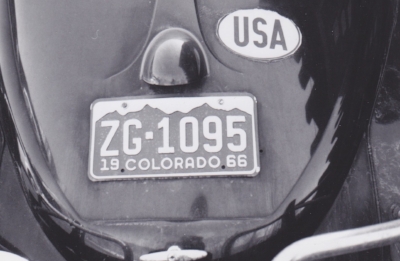A different perspective of an adaptable Aspen…
These photos of Aspen were taken by my stepmother Margery, starting in the Spring of 1966. Back in those days the population of Aspen topped off at 2,000 year-round residents. The ski resort of Snowmass had yet to be discovered. Back in the late 1800’s Aspen was a silver mining bonanza. Miners came from all over the world to strike it rich. Fast forward a hundred years: most all the silver and precious metals had been extracted from mines that riddled the landscape. There were hundreds of miles of tunnels going through Aspen Mountain—it was a miracle the mountain didn’t collapse onto itself.
Promises of riches eventually faded…
What remained of the town and surrounding valleys after tens of thousands of miners deserted their dreams of striking it rich? Aspen went through a hibernation period of nearly seventy-five years. The beauty of the Rocky Mountains had been restored, in most part, as scores of winters erased traces of the miner’s untethered ravaging and disrespect of nature.
Some structures have stood the test of time…
As a youth growing up in Aspen, we had the best of several worlds. Besides all the winter and summer sports, there was an entire valley of abandoned buildings and surrounding areas to explore. At one point, I had an entire closet full of old bottles, postcards, letters, and memorabilia from the 1800 and early 1900’s. And I was never disappointed that I never found anything of extreme value, because I found value in everything I collected. The memories I collected were the true treasure. Decades later— I could not deny Aspen as the perfect setting for my memoir, The Uris Trinity.
Margery saw beauty in simplicity…
Not to miss the perfect picture, Margery carried a camera in her car wherever she went. We went on several photography expeditions within the surrounding areas. She didn’t care that these shots were not in color. Margery could afford color photography… but preferred the versatility and contrast control of black and while photography.
Several rivers forged Aspen’s three valleys…
Hunter Creek, Castle Creek, Maroon Creek and the Roaring Fork River make up the main rivers running through the town of Aspen. Each valley had its own tributary and eventually of them merged down valley into the Roaring Fork River. The Aspen area is the pinnacle of natural beauty to be found in the Rocky Mountains. When you reach Aspen, you reached the end of the road—there is no more territory to discover.
Tree and telephone poles…
Because of the granite and rocky soil, early Aspen ran exposed utilities. Each new telephone pole left another scar on the pristine landscape. Hats off to the 21st Century reclamation of nature’s pristine qualities. With even more new technologies, in another decade, most of the scars will be removed or replaced.
I loved this photo Margery shot and displayed…
At first glance one might suspect something is odd about this photo. Simply put, the photo is upside down. Margery blew up this photo to poster size and I put it on my bedroom wall. This is the world through her eyes… the way she wanted me to display the photo—upside down. She told me, “If you think about it, the world is both up and down. If you see the world as others do, then you see the entire world.” Thanks Margery… I see a sky full of snow with trees shooting downwards like lightning bolts reaching out from the snow-covered sky.
Photos: Margery Ariel Uris
Find The Uris Trinity at Amazon.com
Read Michael’s blog/journal at” www.michaelcadyuris.com
Follow Michael on Facebook: fb.me/TheUrisTrinity






